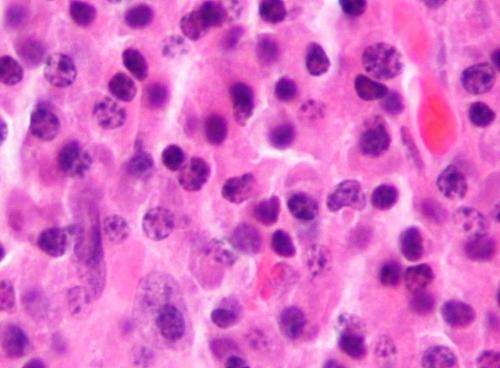This article has been reviewed according to Science X's editorial process and policies. Editors have highlighted the following attributes while ensuring the content's credibility:
fact-checked
peer-reviewed publication
trusted source
proofread
12-year genetic study identifies unique types of multiple myeloma

An unprecedented effort to sequence the genome, exome and RNA in tumors from patients with multiple myeloma defines distinct subtypes of the disease, according to an international team of scientists led by researchers from the Translational Genomics Research Institute (TGen), part of the City of Hope.
The findings of the 12-year observational study provide a clearer picture of the genetic changes that may be important in each subtype of this cancer of our antibody producing plasma cells, which is treatable but incurable. This information could help guide more personalized treatments in the future, the researchers write in Nature Genetics.
The scientists identified the genetic basis for a high-risk patient population, named "PR," that is associated with a median survival of under two years compared to the average survival in the study that exceeds eight years. About 25% of patients transitioned to the PR subtype during the study, and those who transitioned to PR had worse outcomes, with a median survival of 88 days after the transition.
"We've known about this subtype for over a decade and now replicated that this is a high-risk group of patients with the therapies used today. Clearly, these are patients who we need to get on clinical trials because the current drugs just don't work for them," said Jonathan Keats, Ph.D., assistant professor, director of Bioinformatics and Collaborative Sequencing Center at TGen, and a senior author on the paper.
"What we clearly showed is that there is a genetic basis for people being in the PR subgroup."
The study also "helps to highlight that late-stage disease is not like early-stage disease, and in an era where we're moving into early detection, drugs that work in the early stage may not be the drugs that work at the very late stage," Keats added.
The Multiple Myeloma Research Foundation (MMRF) Relating Clinical Outcomes in Multiple Myeloma to Personal Assessment of Genetic Profile (CoMMpass) study included 1,143 patients from 84 clinical sites located in the United States, Canada, Spain and Italy, enrolled between 2011 and 2015 and followed patients for at least eight years after diagnosis.
It is the largest single sequencing study of multiple myeloma patients to date, based on the number of patients and the number of sequencing assays performed.
"There's also clinical data on these patients collected every three months throughout their entire disease course, not just when they're genetically profiled, which is an absolute treasure trove," said Keats.
Two main groups of multiple myeloma patients have been known for some time: a hyperdiploid group with extra copies of chromosomes in tumor cells, and a non-hyperdiploid group with chromosomal rearrangements. The approach used by the current team of researchers helped them identify different subgroups within these broad categories.
"A lot of studies have looked at one method—they look at copy number state, or another one looks at if there are mutations—very few actually integrate the two to really understand how an individual gene is functioning in that patient," Keats noted. "For the field, we've provided a very robust list of candidate genes that are important in the disease."
Keats said the findings could change how doctors speak with their patients about crafting a treatment plan. Although the common belief is that hyperdiploid patients have more favorable overall survival, for instance, the researchers found that "hyperdiploid" encompasses five different groups of patients—one of which has significantly worse outcomes and could benefit from aggressive therapy.
One of the next challenges is to match medicines with specific genetic features, Keats said. "We've definitely answered the question of what different types there are, but not which drugs they best respond to."
TGen is building on this pioneering work to bring personalized medicine to multiple myeloma patients by launching clinical-grade whole genome sequencing in the TGen Clinical Lab. This test will provide patients and their care team with a complete picture of the genetics of each tumor along with prognostic information and therapeutic recommendations within 48 hours.
More information: Sheri Skerget et al, Comprehensive molecular profiling of multiple myeloma identifies refined copy number and expression subtypes, Nature Genetics (2024). DOI: 10.1038/s41588-024-01853-0

















